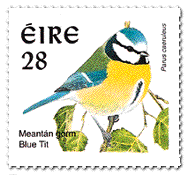
Blue Tit (Meantán Gorm) 28p
 The Blue tit is one of
the most common birds to be found in Irish gardens. You would know it by its blue head and
yellow breast. My Nan sometimes puts a little bag of nuts in the garden for the birds. I
often see blue tits hanging upside down pecking at the nuts. They never fall off. They are
very busy little birds. They often build nests in nest boxes found in some gardens.
The Blue tit is one of
the most common birds to be found in Irish gardens. You would know it by its blue head and
yellow breast. My Nan sometimes puts a little bag of nuts in the garden for the birds. I
often see blue tits hanging upside down pecking at the nuts. They never fall off. They are
very busy little birds. They often build nests in nest boxes found in some gardens.
They never build nests where there are cats because they would get killed very easy.The female lays about three to four eggs early in spring. The female tit builds the nest. She looks for a hole in a wall or a garden box. She gets moss ,grass, wool, leaves, and roots to line the nest. She lines the nest with hair and feathers. I wonder how she knows how to build a nest? Some bad boys go looking for birds eggs and breaking them.
Only one in ten birds live because of cats, other bigger birds and disease. Birds leave
their nest at the end of summer and set out on their own. In winter they eat nuts and
anything they can get their busy beaks into.They hate frosty weather because the ground
gets hard and food is scarce.
My Nan told me that they love drinking milk by pecking the top off the milk bottles but
this doesn’t happen much these days because we do not get our milk in bottles anymore
,it comes in cartons. Also most people have to go to the shops to buy milk as the milkman
only delivers in the towns. In some parts of England they still deliver milk in bottles.
The blue tit is a lovely little bird. Keep an eye out for them in your garden.I saw an
English stamp with a picture of a bluetit, hanging upside down, pecking at food. Most boys
in the Stamp Club think that there is a mistake( called an error) in the stamp, but that
is the way it was printed.
The stamp was issued in Phase 1 on January 16th. 1997.
Written by-:John Kelly